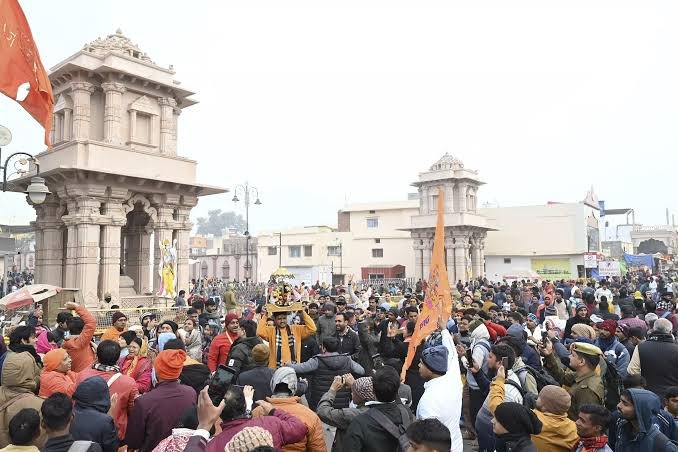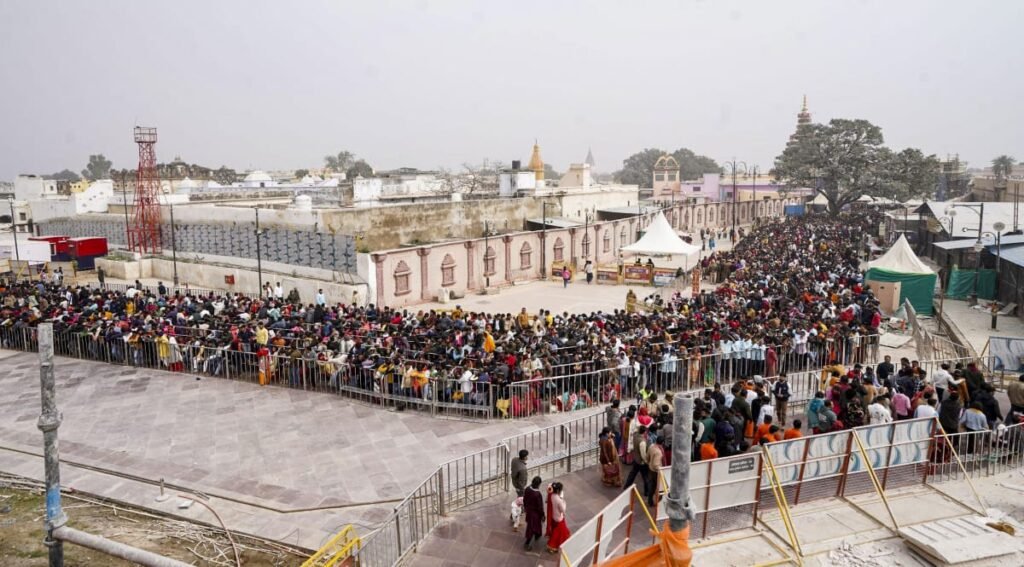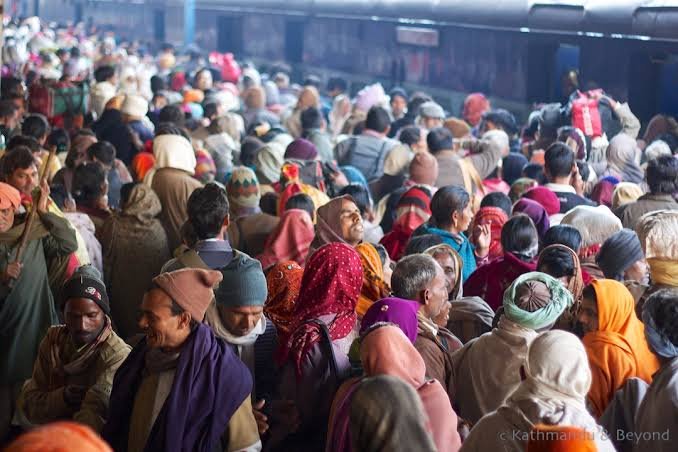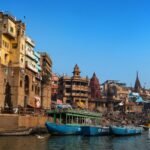Introduction
Varanasi, the spiritual heart of India, is witnessing an unprecedented surge in devotees as the Maha Kumbh reverse flow reaches the city. With the ongoing Divya Maha Kumbh in Prayagraj drawing millions, its ripple effect is now being felt in Kashi, leading to overwhelming crowds at the Kashi Vishwanath Dham and other sacred sites. The city administration, police, and security forces are on high alert, ensuring smooth crowd management and safety measures.

Surge in Devotee Footfall at Kashi Vishwanath Dham
On Friday, the Kashi Vishwanath Temple experienced an extraordinary influx of pilgrims. The queue of devotees extended from Gate No. 4 through Chowk, Nichibagh, Bulanala, Maidagin, and Kotwali. With two lines of barricaded queues inside the temple premises, authorities ensured a structured flow of devotees for darshan.
Thousands of devotees, some of whom had traveled from across the country, patiently waited for hours to get a glimpse of the deity. Many pilgrims expressed their devotion by chanting hymns and singing bhajans while waiting in line. The temple administration has made additional arrangements, including setting up water dispensers, medical aid stations, and volunteer assistance points to facilitate the movement of devotees.
Impact of Maha Kumbh on Varanasi
The ongoing Maha Kumbh in Prayagraj, which will continue until February 26, has led to an overwhelming increase in devotees visiting Varanasi. Many pilgrims are arriving in Kashi after their visit to the Sangam in Prayagraj, seeking blessings at the Kashi Vishwanath Temple and taking holy dips in the Ganges.

The spiritual significance of Varanasi amplifies during such religious congregations. Pilgrims believe that visiting Kashi during the Maha Kumbh enhances the merit of their pilgrimage, making it a spiritually transformative experience. Additionally, several religious organizations have set up camps offering free meals, discourses, and other services for visiting devotees.
Security Arrangements and Crowd Management
Given the unprecedented surge, the district administration and police have implemented stringent security measures. Senior officials, including DCP Gaurav Kumar Banswal, have been actively monitoring the situation. Key arrangements include:
- Traffic Diversions: To prevent congestion, diversions have been imposed at major junctions, including Ramapura to Sonarpura.
- Surveillance Systems: CCTV cameras and drones have been deployed across key locations, including temples, ghats, and main roads.
- Waterway Monitoring: Boats ferrying pilgrims in the Ganges are under strict surveillance by the water police to prevent overcrowding and ensure safety.
- Additional Deployment: More than 5,000 police personnel have been deployed across Varanasi, with rapid action teams stationed at critical points.
- Medical Readiness: Emergency medical teams are on standby at major ghats and temple premises to provide immediate assistance in case of any health issues among the devotees.
Heavy Rush at Ghats and Major Points
Alongside the temple, the ghats of Varanasi, including Dashashwamedh Ghat, Assi Ghat, and Manikarnika Ghat, have witnessed an enormous influx of pilgrims. The administration has intensified security at these locations, deploying additional forces and emergency response teams to manage the situation effectively.

Devotees gathered at the ghats early in the morning to take holy dips in the Ganges, believing that the sacred waters wash away sins and grant them spiritual liberation. Priests and saints have been conducting yajnas and special prayers along the riverbanks, creating a deeply spiritual ambiance.
The ghats have also become the center of various cultural and religious activities. Groups of sadhus, musicians, and spiritual speakers have been engaging devotees with discourses, kirtans, and spiritual dialogues. The mesmerizing Ganga Aarti at Dashashwamedh Ghat has been drawing thousands of spectators, turning it into a breathtaking visual spectacle each evening.
Pilgrims’ Experience and Devotional Fervor
The spiritual ambiance in Kashi has reached a peak with devotional chants, bhajans, and rituals being performed at the temple and along the ghats. Pilgrims, despite the long queues and extended waiting periods, have expressed their deep faith and reverence, believing the experience to be a divine blessing.
Many devotees have shared their personal experiences of spiritual fulfillment, narrating stories of how their visit to Varanasi during this auspicious time has transformed their lives. Some pilgrims have traveled from far-off locations, including different states of India and even abroad, to be part of this sacred congregation.
Challenges in Managing the Rush
With such a large number of devotees pouring into the city, certain challenges have arisen:
- Accommodation Shortages: Hotels, dharamshalas, and lodges are fully booked, leaving many pilgrims struggling to find a place to stay.
- Sanitation and Waste Management: The high footfall has increased the burden on sanitation workers, requiring additional efforts to maintain cleanliness.
- Traffic Congestion: Despite diversions, certain areas have experienced bottlenecks due to the sheer volume of visitors.
- Food and Water Supply: Given the large crowds, ensuring an adequate supply of drinking water and food distribution has become a logistical challenge.
- Medical Emergencies: Elderly pilgrims and those with health conditions have faced difficulties due to long waiting hours and crowded conditions.

Authorities’ Response to Challenges
To address these issues, the administration has:
- Set up temporary shelters and community centers for devotees.
- Increased the number of sanitation workers to ensure cleanliness across temple premises and ghats.
- Deployed additional traffic personnel to streamline vehicle movement and pedestrian flow.
- Established multiple medical aid stations with quick-response teams to assist those in need.
- Introduced special buses and e-rickshaws for facilitating movement across the city.
Significance of the Maha Kumbh Reverse Flow in Varanasi
The Maha Kumbh, held every 12 years, is one of the largest religious gatherings in the world. While Prayagraj remains the epicenter, Varanasi, being one of the holiest cities in Hinduism, naturally witnesses a reverse flow of pilgrims. This phenomenon underlines the deep-rooted spiritual connection between these two sacred cities.

This reverse flow also has economic implications, with the influx of tourists boosting local businesses, including hotels, restaurants, souvenir shops, and transport services. The spiritual tourism sector thrives during such occasions, providing employment opportunities to thousands of people in the city.
Conclusion
As the Maha Kumbh continues in Prayagraj, Varanasi remains a focal point for millions of devotees. With meticulous planning and dedicated efforts by authorities, the city is managing the massive influx efficiently. Despite the challenges, the divine energy and spiritual atmosphere in Kashi make this experience a once-in-a-lifetime event for pilgrims, reaffirming its eternal status as the city of Lord Shiva.
Varanasi, with its blend of ancient traditions and modern management strategies, continues to uphold its legacy as the spiritual capital of India, welcoming devotees with open arms and ensuring that their journey remains a spiritually enriching and memorable one.







